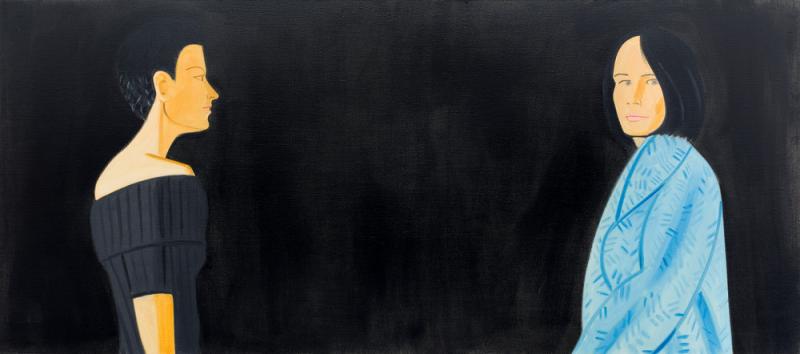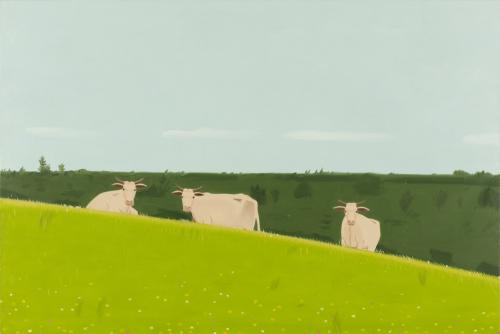Skip to main content
Rachael and Tarajia
Artist
Alex Katz
(American, born 1927)
Date2014
MediumOil on linen
DimensionsOverall: 48 × 108 in. (121.92 × 274.32 cm)
Credit LineCollection of the Modern Art Museum of Fort Worth, Museum purchase
Object number2017.2
Status
Not on viewCopyright© 2020 Alex Katz / Artists Rights Society (ARS), New York
Category
Label TextSince the 1950s, Alex Katz has painted portraits that distill the physiognomies of his sitters to their most essential aspects. Katz was born in Brooklyn in 1927 and came of age as an artist in the late 1950s, after Abstract Expressionism had been established as the dominant style but before the advent of Pop art. Uninterested in the performative heroics associated with Abstract Expressionism, he committed himself to depicting the people, places, and objects around him, developing a style characterized by flat fields of color, simple forms, and minimal detail.
Around 1960, Katz began to work on a large scale, presenting looming, dramatically lit individuals or groups of people on monochrome grounds. The monumental portrait—an unusual undertaking in contemporary art—has continued to sustain him since, as seen in the Modern’s double portrait, Rachael and Tarajia, 2014. The work belongs to Katz’s “black” paintings series, which position the subjects against a stark black background.
At four feet tall and nine feet wide, the Modern’s canvas suggests a widescreen cinema format. Instead of placing his sitters in the center of the composition, the artist pushed the women to the opposite margins, creating a gulf of black space between them that takes up the majority of the painting. The only light emanates from the figures themselves. The woman on the left, depicted in profile, gazes toward the woman on the right, who turns to meet the viewer’s eyes. The two do not seem to interact, however, giving rise to the possibility that they were never in the same space to begin with, that Katz invented their encounter in order to produce a striking pictorial image. Katz’s approach, as ever, is coolly distant. His portraits are as emotionally self-contained as icons.
Around 1960, Katz began to work on a large scale, presenting looming, dramatically lit individuals or groups of people on monochrome grounds. The monumental portrait—an unusual undertaking in contemporary art—has continued to sustain him since, as seen in the Modern’s double portrait, Rachael and Tarajia, 2014. The work belongs to Katz’s “black” paintings series, which position the subjects against a stark black background.
At four feet tall and nine feet wide, the Modern’s canvas suggests a widescreen cinema format. Instead of placing his sitters in the center of the composition, the artist pushed the women to the opposite margins, creating a gulf of black space between them that takes up the majority of the painting. The only light emanates from the figures themselves. The woman on the left, depicted in profile, gazes toward the woman on the right, who turns to meet the viewer’s eyes. The two do not seem to interact, however, giving rise to the possibility that they were never in the same space to begin with, that Katz invented their encounter in order to produce a striking pictorial image. Katz’s approach, as ever, is coolly distant. His portraits are as emotionally self-contained as icons.






